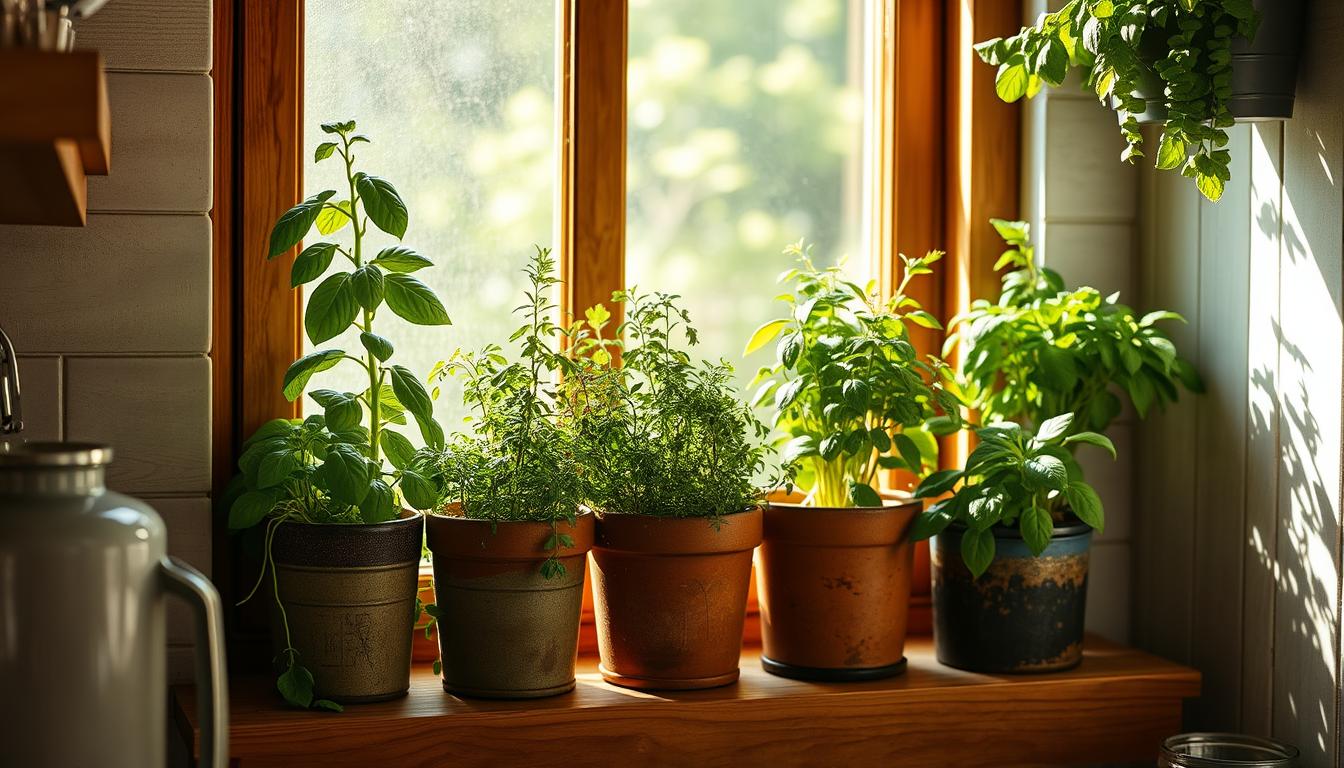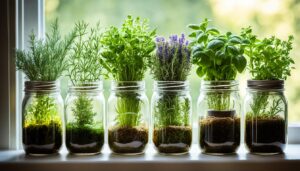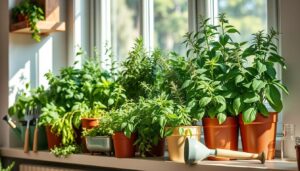Ever thought about keeping your favorite herbs fresh all year without leaving your home? An indoor herb garden is a perfect solution. It lets you have fresh herbs anytime you want. Plus, it makes your cooking better and cuts down on waste from buying herbs.
This guide will show you how to start and keep an indoor herb garden. You’ll learn about the best lighting and which herbs work best. No matter the size of your kitchen, you can have a beautiful herb garden. It can be on your kitchen wall or on your windowsill, bringing fresh flavors into your home.
With some knowledge and effort, you can grow your own herbs indoors. This means better cooking and less need for store-bought herbs. Get ready to enjoy a thriving indoor herb garden that’s easy and Fresh.
Importance of Proper Lighting for Indoor Herb Gardens
Creating a successful indoor herb garden means paying attention to lighting. Most herbs need 4-6 hours of direct sunlight daily. Knowing the lighting needs of different herbs helps you grow a garden that thrives indoors, even without sunlight.
South- or West-Facing Windows
Herbs like rosemary, sage, thyme, marjoram, basil, and oregano love full sun. If your garden is near south- or west-facing windows, they’ll get the sunlight they need. This natural light helps these herbs grow and taste great.
North- or East-Facing Windows
For herbs like mint, chives, and lemon balm, partial shade is better. North- or east-facing windows offer soft, diffused light. This is perfect for herbs that prefer less intense light.
Indoor Herb Garden with Grow Light
If your space doesn’t get enough natural light, a grow light can help. These lights mimic sunlight, giving your herbs the light they need. Turn the grow light on for 12-14 hours a day to keep your herbs healthy and low-maintenance indoor herbs.
“Proper lighting is the foundation of a thriving indoor herb garden. By understanding the unique needs of your herbs, you can create a lush, flavorful oasis, even in the absence of natural sunlight.”
Top Indoor Herb Garden Setups Reviewed
If you’re starting an indoor herb garden as a beginner, it’s key to look at the best options for your needs and space. We’ve checked out several top indoor herb garden setups to help you pick the right one.
The AeroGarden Harvest Elite is a great choice. It has a user-friendly digital display, lets you grow up to six plants at once, and has different lighting modes. It even has a “vacation mode” for when you’re away. For more control, the iDOO Hydroponic System lets you start herbs from seed, giving you a personalized experience.
If space is tight, the Click & Grow Indoor Herb Garden is perfect. It’s compact and fits well in your home. This self-watering system makes indoor herb gardening easy, making it great for beginners.
| Product | Features | Pros | Cons |
|---|---|---|---|
| AeroGarden Harvest Elite | – Grows up to 6 plants at once – Digital display with automatic reminders – Vacation mode for hands-off care |
– User-friendly setup – Variety of lighting modes |
– Limited customization options |
| iDOO Hydroponic System | – Grow herbs from seed – Customizable settings – Automatic water level detection |
– Highly customizable – Includes seed starter kit |
– Requires more maintenance |
| Click & Grow Indoor Herb Garden | – Compact and stylish design – Self-watering system – Includes plant pods |
– Minimal effort required – Fits in small spaces |
– Limited plant selection |
Looking for indoor herb garden lighting tips or diy indoor herb garden kits? These top setups have many features and benefits. They help you grow a successful indoor herb garden.
Setting Up and Maintaining an Indoor Herb Garden
Starting an indoor herb garden is rewarding, whether you grow from transplants, cuttings, or seeds. Each method has its own benefits and things to consider. By knowing how to set up and maintain your garden, you can keep your herbs thriving all year. This means you’ll always have the best herbs for kitchen windowsill and herbs that thrive indoors.
From Transplants
Transplanting herbs like rosemary, oregano, thyme, sage, and bay laurel is easy. These plants are already grown and can quickly adjust to indoor life. They need less care than starting from seeds.
From Cuttings
Using cuttings from herbs like basil, mint, and rosemary can save money and grow your garden. With the right indoor herb garden watering tips, these cuttings can flourish and give you a lot of herbs.
From Seed
Starting herbs like basil, parsley, cilantro, and lemon balm from seed is rewarding but takes more time and effort. You need to prepare the soil well and water your plants regularly for them to grow well.
No matter how you start your garden, make sure the soil drains well and water consistently. Pruning and cleaning your plants often will keep them healthy and productive.
“Growing your own herbs indoors is a game-changer. You’ll have a steady supply of fresh, flavorful ingredients right at your fingertips.”
Best Herbs for Indoor Gardening
Not all herbs do well indoors. But, some are perfect for indoor gardens and need little care. These “herbs that thrive indoors year-round” are great for beginners. They include:
- Basil
- Bay laurel
- Chervil
- Chives
- Mint
- Oregano
- Parsley
- Rosemary
- Thyme
These hardy herbs give you fresh, aromatic leaves for cooking. Many are perennials, lasting for years with the right care. While basil might need replanting, most of these herbs are easy to keep and can grow indoors.
“Growing your own herbs indoors is a game-changer – you’ll never go back to store-bought once you taste the difference freshly harvested makes.”
Whether you’re an expert or a beginner, these herbs are versatile and will do well. They provide a steady harvest all year.
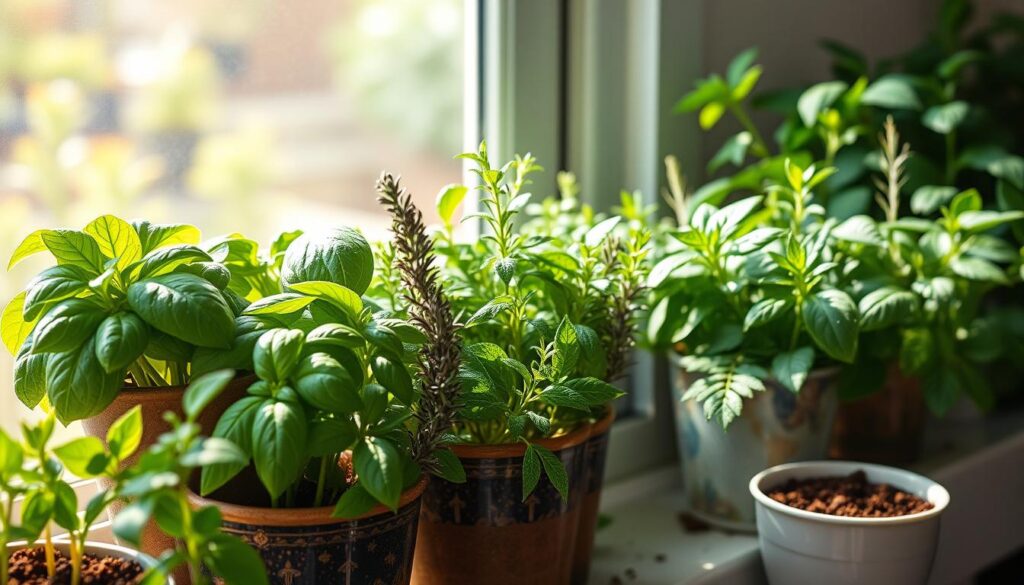
Indoor Herb Garden: Fresh & Easy
Having an indoor herb garden lets you enjoy fresh herbs that thrive indoors year-round, even in small spaces. With the right lighting and indoor herb garden watering tips, your herbs will flourish. This makes your cooking more exciting.
Growing herbs indoors is great. You get to have flavorful herbs ready whenever you need them. Plus, it’s easy to take care of an indoor garden. You can pick herbs for your recipes without the trouble of an outdoor garden.
- Enjoy a year-round supply of fresh herbs, even in small spaces.
- Enhance your cooking with the vibrant flavors of homegrown herbs.
- Cultivate a self-sustaining indoor garden with minimal effort.
For a successful indoor herb garden, focus on lighting requirements and watering needs. Windows facing south or west get enough sun. But, windows facing north or east might need a grow light. Also, follow indoor herb garden watering tips like checking soil moisture and adjusting your watering schedule.
“Growing an indoor herb garden is a wonderful way to bring the fresh flavors of nature into your home, all year round.”
With careful planning and attention, your indoor herb garden can be a source of inspiration and a peaceful spot in your home. Harvest your own herbs whenever you want, adding convenience and joy to your cooking.
Space-Saving Tips for Indoor Herb Gardens
Creating an indoor herb garden in small spaces like apartments or kitchens is rewarding. With creativity, you can grow a thriving herb collection at home. Here are some tips to make the most of your space for an indoor herb garden.
A vertical growing system is a smart choice for small gardens. It lets you stack planters or tiers, growing many herbs in a small area. Wall-mounted planters are also great, saving floor space and adding style to your garden.
For sunny windowsills, a windowsill herb garden is perfect. These gardens get plenty of natural light and are easy to care for. Choose compact herbs like thyme or oregano that fit well in small spaces.
With a little creativity, you can cultivate a thriving indoor herb garden even in the most compact of living spaces.
Using these tips, you can enjoy fresh herbs at home, even with limited space. Indoor herb gardens add nature indoors and improve your cooking.
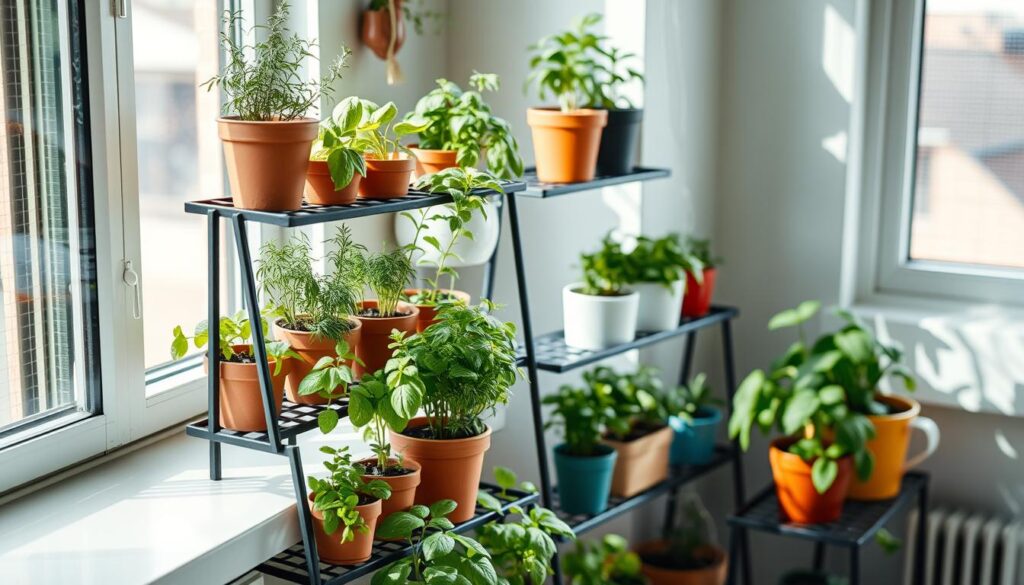
Adjusting Indoor Herb Garden Lighting
Getting the right lighting is key for your indoor herb garden’s success. As your herbs grow, their lighting needs change. You must adjust the lighting to give them the best amount of light.
Many indoor herb garden systems have adjustable grow lights. You can move these lights up or down to get the perfect light intensity for your plants. This lets you tailor the lighting to what your herbs need.
Keep an eye on your plants and change the lighting as needed. Most indoor herbs need 12-14 hours of light each day. This is true especially during the winter when days are shorter. By watching your plants and adjusting the light, you help them grow well and keep their flavor strong.
| Lighting Needs | Herb Growth Stage |
|---|---|
| 12-14 hours of light per day | Seedlings and young plants |
| Adjustable grow light intensity | Mature plants |
| Increased light during winter months | All stages |
Understanding the importance of proper lighting helps you create a thriving indoor herb garden. This way, you get fresh, tasty herbs all year.
“Lighting is one of the most critical factors in growing a successful indoor herb garden. Pay close attention to your plants’ needs and adjust the lighting accordingly.”
Troubleshooting Common Indoor Herb Garden Issues
Keeping an indoor herb garden can be rewarding, but it’s not always easy. You might face challenges, but knowing how to fix them can help. This way, you can keep your best herbs for indoor growing beginners and low-maintenance indoor herbs healthy and productive.
One big issue is when herbs grow too long or too short. This usually happens if they don’t get enough light. Make sure they sit in a spot that gets a lot of sunlight, like a window on the south or west side. If that’s not possible, use a grow light to help them grow.
Herbs can also wilt or turn yellow if you water them too much or too little. To fix this, water them regularly but don’t stick to a set schedule. Check the soil often and water when it feels dry. Don’t let the soil get too dry or stay wet for a long time.
Sometimes, indoor herb gardens get pests like scale insects. Check your plants often for any pests. If you find any, use safe pest control products like neem oil or insecticidal soap to get rid of them.
| Common Issue | Possible Causes | Solutions |
|---|---|---|
| Leggy or stunted growth | Insufficient lighting | Provide more natural sunlight or use a grow light |
| Wilting or yellowing leaves | Over- or under-watering | Establish a consistent watering routine and monitor soil moisture |
| Pest infestations | Scale insects or other pests | Use organic pest control methods like neem oil or insecticidal soap |
By watching your indoor herb garden closely and making changes as needed, you can beat most problems. This way, you can enjoy a beautiful, low-maintenance indoor herb garden at home.
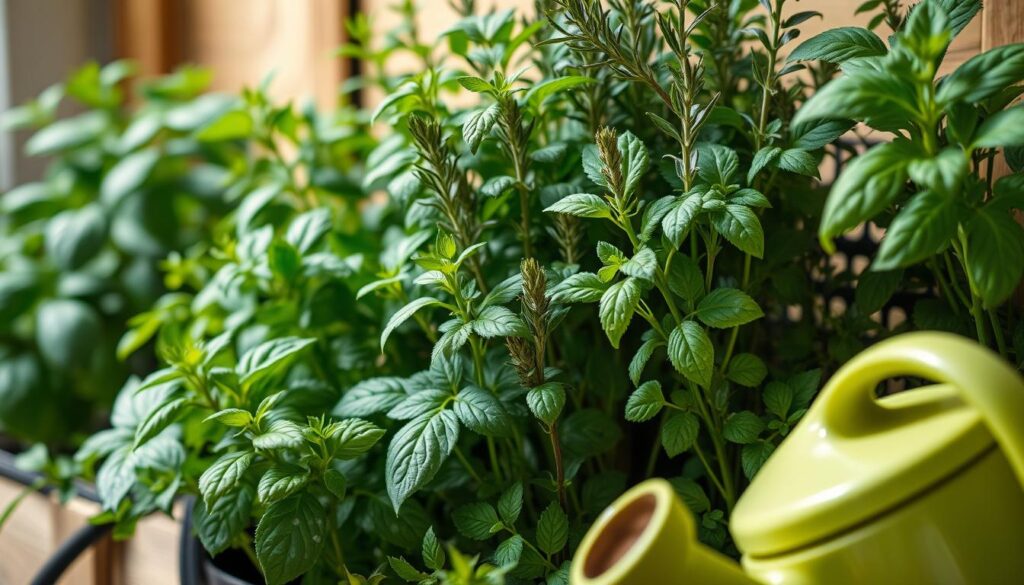
“With a little troubleshooting and patience, you can keep your indoor herb garden flourishing.”
Hydroponic vs Soil-Based Indoor Herb Gardens
When you start an indoor herb garden, you can choose between hydroponic or soil-based systems. Both can work well for growing herbs indoors. But, they have different needs and benefits.
Hydroponic gardens feed plants in water full of nutrients, not soil. This method can make plants grow faster and control nutrients better. Soil-based gardens use potting mix to grow herbs. They’re simpler to keep up but need more watering and watching.
| Hydroponic Indoor Herb Garden | Soil-Based Indoor Herb Garden |
|---|---|
| Faster growth | Slower growth |
| More precise nutrient control | Less precise nutrient control |
| Requires specialized equipment | Requires basic gardening supplies |
| Potentially higher initial cost | Typically lower initial cost |
The choice between hydroponic or soil-based gardens depends on what you like, how much space you have, and your gardening skills. Both can make great indoor herb gardens. Think about what you need and pick the best fit for your life.
Conclusion
Growing an indoor herb garden is rewarding and practical. It lets you enjoy fresh, flavorful herbs all year, even in small spaces. By knowing how to pick the right herbs and set up your garden, you can have a thriving indoor herb garden.
This garden will make your cooking better and help reduce waste. With a bit of care, you can enjoy the taste of homegrown herbs right in your kitchen. It’s great for both experienced gardeners and beginners.
Starting an indoor herb garden diy project is fulfilling. Using indoor herb garden ideas for small spaces, you can grow herbs even in tiny areas. This way, you get the taste of fresh herbs without much space.
Creating your own indoor herb garden is a journey of discovery and joy. Try different herbs and setups to see what works best. Soon, you’ll have a garden that adds flavor to your meals and brightens your life.
FAQ
What are the best herbs for indoor growing?
How much sunlight do indoor herbs need?
Can I grow an indoor herb garden without natural sunlight?
What are the top indoor herb garden setups to consider?
How do I set up and maintain an indoor herb garden?
What are some space-saving techniques for indoor herb gardens?
How do I troubleshoot common indoor herb garden issues?
Should I choose a hydroponic or soil-based indoor herb garden?
Source Links
- How to Grow Herbs Indoors | Gardener’s Supply – https://www.gardeners.com/how-to/herbs-indoors/8920.html?srsltid=AfmBOoryo5wA3caRPKMobj8LGrSEQ9w1LD8a1b0ov_JUDWniY59hp-3t
- I Spent Months Testing Indoor Herb Gardens to Find Out Which Three Worked Best – https://www.seriouseats.com/best-indoor-herb-gardens-7563224
- How to Start an Herb Garden Indoors • Gardenary – https://www.gardenary.com/blog/how-to-start-an-herb-garden-indoors


